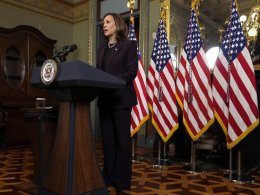The Islamic Republic of Iran and the Russian government are building a new transcontinental trade route stretching from the eastern edge of Europe to the Indian Ocean, a 3,000–kilometer (1,860 miles) passage that is beyond the reach of any foreign intervention, according to a Wednesday report by Bloomberg.
According to the report, the two governments are spending billions of dollars to quickly increase cargo delivery along rivers and railways linked by the Caspian Sea, with dozens of sanctioned Russian and Iranian vessels plying the routes.
Under intense economic pressure from international sanctions, Russia and Iran are turning toward each other to shield commercial links from Western countries and build new ones with Asian countries like China.
Experts familiar with this project note that Iran and Russia are trying to establish "sanctions-proof supply chains," allowing both regimes to shave thousands of kilometers off existing routes.
At the northern end of this new route is the Sea of Azov, linked with the Crimean Peninsula, Ukraine’s southeastern coast, including the Russian-occupied port of Mariupol and the mouth of the River Don.
In early December, Russian President Vladimir Putin said that the Sea of Azov has become "an inland sea" for Russia.
From the water and rail networks are the Iranian hubs on the Caspian Sea and the Indian Ocean, where Russia has marked the importance of the route's end.
At a September economic forum, the Russian President stressed the need to develop a ship, rail, and road infrastructure along the new pathway to help Russian companies with new means of entering the marks of Iran, India, the Middle East, and Africa to generate supplies from these countries.
Experts noted that Russia and Iran are investing as much as $25 billion in the inland trade corridor to generate the flow of goods like weapons that Western countries want to stop.
"It is an area we’re watching carefully, both that route and more generally the Iranian–Russian connection," said the Biden administration’s official, James O’Brien, after announcing new punishments last week that target executives at Russian Railways. "We are concerned with any effort to help Russia evade the sanctions."
According to the Biden administration's Iran envoy, Robert Malley, the new trade route needs scrutiny stating that the decision by Tehran and Moscow is "extraordinarily damaging" and "reckless."
While ships sailing the Don Volga rivers have traded energy and agriculture products, the two countries have now announced several new business transactions. The goods that will be shipped include turbines, polymers, medical supplies, automotive parts, and Russian-supplied nuclear fuel and components for Iran's reactor in Bushehr. Additionally, both countries are spending enormous amounts of money to overcome obstacles they may face.
The report from Bloomberg says that Moscow is finalizing rules that would give ships from Iran the right of passage along inland waterways on the Volga and Don. According to reports, at least a dozen Iranian vessels sanctioned by the United States and other countries are plying the waters between the country’s Caspian coast and key Volga River ports.
The Islamic-Republic-based Shipping Lines Group made a $10 million investment in a port along the Volga in November, according to an Iranian Labour News Agency.
The new aim is to double the cargo capacity at the Solyanka Port in the Russian city of Astrakhan to 85,000 tons a month.
The Islamic Republic is also pouring money into terminals where cargo can be rolled off ships and onto railroads that travel across the country from the Caspian to the Persian Gulf, expanding its rail network.
Officials in the Islamic government are focused on what they describe as the "Eastern axis," scrapping any plans to revive economic relations with Western European countries and instead pursuing trade and energy agreements with Russia, China, and Central Asian nations.
Ever since Putin announced his invasion of Ukraine in February, the Russian economy has faced intense international economic pressure from the West, resulting in significant financial loss in the Russian economy and military resources for Russia's military forces.
In response, Putin has resorted to dealing with countries like Iran and China to provide economic relief from international sanctions and military aid in the form of ammunition and Iranian-made drones.
It appears that in exchange for Iran's support to Putin's forces, Moscow has helped Tehran combat the ongoing protests in the country which were sparked after the death of 22-year-old Mahsa Amini in September at the hands of the morality police.
With the invasion of Ukraine still ongoing and protests continuing into the fourth month throughout Iran, experts believe that both regimes will continue to support one another despite international pressure.
Related Story: U.S. Officials Say Russia Supplying Advanced Military Assistance to Iran










